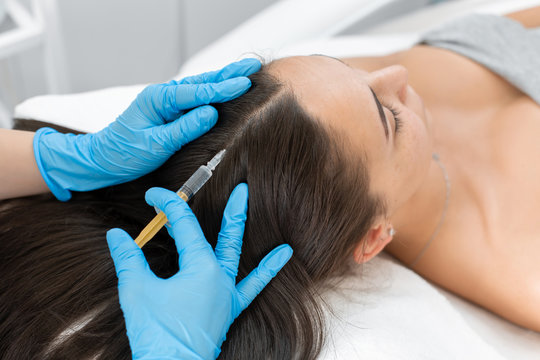PRP Hair Treatment in Abu Dhabi is generally considered a safe and effective solution for hair thinning and hair loss. However, like any medical procedure, there are some potential risks and considerations to be aware of. It’s important to understand these risks before deciding to undergo treatment. Below are some possible risks associated with PRP hair treatment:
1. Infection
Since PRP treatment involves drawing blood and injecting the platelet-rich plasma into the scalp, there is a small risk of infection at the injection site. However, the risk of infection can be minimized by ensuring that the procedure is performed in a sterile environment by a trained professional.
2. Pain or Discomfort
Some discomfort or pain during and after the procedure is common. The injection sites may cause temporary soreness, itching, or a mild headache. However, this usually resolves within a few hours to a couple of days. A local anesthetic may be applied to the scalp to minimize discomfort during the procedure.

3. Swelling or Redness
Redness and mild swelling at the injection site are possible side effects. This typically subsides within a few hours to a day after the procedure. It’s a normal reaction to the injections and doesn’t usually cause any long-term issues.
4. Bruising
Small bruises may appear at the injection points on the scalp. This is typically a temporary side effect and fades within a few days. However, if bruising is significant or persists for an extended period, it is a good idea to consult your practitioner.
5. Uneven Results
While PRP is effective for many people, the results can vary. Some individuals may experience significant hair regrowth, while others may have more modest results. It’s important to have realistic expectations and understand that not everyone will achieve the same outcome. In some cases, multiple sessions may be needed to see the best results.
6. Allergic Reactions
Although rare, some individuals may have an allergic reaction to the local anesthetic used during the procedure. Symptoms may include rash, itching, or swelling. It’s important to inform your healthcare provider if you have any allergies or sensitivities before the treatment.
7. Scalp Tightness
Some individuals experience mild scalp tightness or sensitivity in the area treated with PRP. This is typically temporary and resolves after a short period. If the tightness persists, it’s important to contact your doctor.
8. Risk of Scarring
In very rare cases, the injection process may result in scarring, particularly if the scalp is subjected to repeated injections or improper technique. However, this is uncommon when the procedure is performed correctly by an experienced professional.
How to Minimize Risks
- Choose an Experienced Provider: Ensure that the PRP procedure is performed by a trained and experienced healthcare provider or specialist who understands the nuances of PRP therapy.
- Follow Aftercare Instructions: Follow all aftercare instructions provided by your provider, including avoiding strenuous activities, sun exposure, and certain hair treatments post-procedure.
- Discuss Medical History: Be sure to disclose your complete medical history, including any medications, allergies, or conditions that might affect the procedure or recovery.
Conclusion
PRP (Platelet-Rich Plasma) hair treatment has become a highly sought-after solution for those experiencing hair thinning and hair loss. This innovative, minimally invasive procedure uses your body’s own platelets to stimulate hair growth and improve the health of the scalp. While generally considered safe with minimal risks, like any medical treatment, it is essential to be aware of potential side effects, including infection, bruising, or temporary discomfort.
The effectiveness of PRP varies from person to person, with most individuals experiencing significant improvements in hair thickness and density after a series of treatments. The procedure is non-surgical and involves minimal downtime, making it a convenient option for those looking for a less invasive hair restoration solution.
FAQs About PRP Hair Treatment in Abu Dhabi
1. What is PRP hair treatment?
PRP (Platelet-Rich Plasma) hair treatment is a non-surgical procedure that uses your own blood to promote hair growth. Blood is drawn from your arm, processed to concentrate the platelets, and then injected into areas of the scalp with thinning or no hair. The growth factors in the PRP stimulate hair follicles and encourage new hair growth.
2. How does PRP work for hair restoration?
PRP works by using growth factors from your own blood to stimulate dormant or weakened hair follicles. When injected into the scalp, these growth factors improve blood circulation, promote tissue repair, and encourage hair regrowth. Over time, the follicles become healthier and stronger, leading to thicker, fuller hair.
3. Is PRP hair treatment painful?
Most patients experience minimal discomfort during the procedure. A local anesthetic is applied to the scalp to reduce pain during the PRP injections. After the treatment, there may be slight soreness or tenderness, but it usually resolves within a few hours to a day.
4. How many PRP sessions are needed for hair growth?
Typically, a series of 3 to 4 PRP treatments are recommended, spaced about 4 to 6 weeks apart. After the initial treatments, maintenance sessions may be needed every 6 to 12 months to sustain the results and continue promoting hair growth.
5. What results can I expect from PRP hair treatment?
Results vary from person to person, but many patients see improvements in hair thickness, density, and overall scalp health. Hair growth typically becomes noticeable after 3 to 6 months, with full results appearing after 9 to 12 months.
6. Are the results permanent?
While PRP can promote long-term hair growth, the results are not permanent. Maintenance treatments are necessary to sustain the benefits, as hair loss can continue due to factors like aging or genetics.
